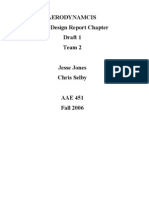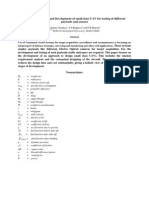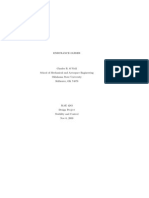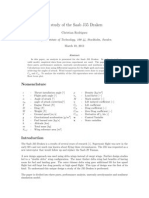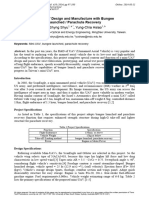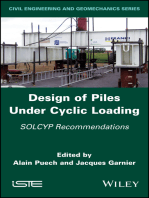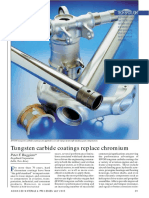L3 Applications Group Exercise Group 4
Uploaded by
api-308221295L3 Applications Group Exercise Group 4
Uploaded by
api-308221295L3 Applications Group Exercise
Group 4
Ciuca, H. Chattha, S. Christie, J. Delpech, C. Chu, C. Cheung, J. Cong
Department of Aeronautics, Imperial College London
Abstract This report presents the design,
manufacturing and testing of a small launchgliding robot. The design employed a mix between a rear wheel drive vehicle (for ramp
launching) and a Glider (for aerodynamic performance). The prototype was powered by a
remote-controlled electric engine, had a total
mass of 46.9g and was capable of travelling a total
distance of 3m. The cost of manufacturing the
robot was 17.8. A mathematical model designed
to predict the performance of the prototype is
detailed and shown to match with experimental
results.
I. INTRODUCTION
The field of Aerial Robotics has been under
continued development since the advent of military drones. Although this type of robot has been
most widely employed in warfare, the potential
for civil applications is endless. One example
would be rescue-type (search and find) missions
and our robot is designed to reach inaccessible
and remote areas using both terrain and launchgliding locomotion. The design requirements can
be found in reference ([1]). The key performance
parameter in our design is the distance between
the base of the ramp and the landing point.
II. PRELIMINARY DESIGN
A. Wing Design & Aerodynamics
A conventional glider design was chosen due
to favourable stability characteristics, high atL
tainable D
and plethora of research information
available ([2],[3],[4]). Nonetheless, wing design
was a challenge, due to a very low Re (Re
16, 000 assuming v = 3ms1 and c = 8cm), and
the fact that the produced lift needs to balance
the weight at the onset of the gliding phase. High
L
D was first established as a key characteristic.
However, the lift generated (for the same assumed velocity) was ten times lower than the
weight. Hence, the wing area was increased
at the expense of an increase in drag. From
the experimental study of a 2D cambered flat
plate at Re 20, 000 ([5]) and using the aerodynamic code QBlade, it was established that a
cambered flat plate allows an increase of 28%
in CLmax relative to the low Re NACA 8805.
Recognising Nature as the pioneer of aerodynamics, we based our wing design on a bat
wing profile (see Figure 2). This was due to the
amazing low-speed aerodynamic performance
of such creatures ([6]).
B. Vehicle Dynamics & Structural Aspects
Keeping the drive train simplistic and lowweight, an in-line gear system, sized for a gear
ratio of 2 : 1, is used to drive the rear shaft. This
has the added benefit of minimising transmission losses. The design aim was to minimise
mass whilst ensuring that the robot maintained
rigidity and stiffness during each test, although,
an overly rigid design would be too brittle to
survive a crash impact. For the initial chassis
design, a basic platform with cut-outs for the
wheels, was manufactured using 3mm Acrylic.
Testingof the acrylic components displayed possible areas of stress concentration. Reducing
the thickness of Acrylic to 2mm and rounding
all sharp corners immediately reduced the mass
of the part, and increased the impact tolerance
of the robot.
C. Stability
Longitudinal and lateral stability are key factors for the success of the mission. In this preliminary design stage only static stability was analysed by enforcing zero net moment around the
c.g. The only potential dynamic instability was a
short pitching oscillation, which would be heavily
damped ([2]). Lateral flight stability was ensured
through careful positioning of the c.g. on the axis
of symmetry. Longitudinal Static Stability plays
a vital role, especially in the transition phase
before gliding, where a good restoring moment
dCM
d < 0 is needed to avoid a nose-down dive.
This was ensured by having a large static margin
given by:
xc.g. lh Sh CLh
+
(1)
Kn =
c
cSw CLw
Where all symbols are as standard ([7]).
III. MATHEMATICAL MODELLING
A. Ground Phase
The A.C. of the body was assumed to coincide with the C.G. of the model, and the drag
and lift of the body were modelled empirically
([8]). The transmission loss was also modelled
empirically as a function of the number of gears
and complexity of the drive train and found to
be roughly 15%. The torque transmitted by the
engine was simulated in Matlab according to
the way the motor control was coded (either
a gradual throttle to full power in time t or a
step-input). The friction coefficient has been
determined experimentally. A Free Body Diagram of our model is shown in Figure 3. Lift
and drag coefficients for the wing and tailplane
were obtained from experimental results for flat
plates with corrections to account for 3D effects
and induced drag was modelled using LiftingLine Theory. A system of 5 equations: rotational
equilibrium of the rear and front wheels, horizontal and vertical equilibrium and sum of moments
about C.G., with 5 unknowns: f , F , Nr , Nf and
x was solved in Matlab to give the ramp exit
velocity. The program gave warnings if the front
or rear wheels would lift off (Nf < 0 or Nr < 0),
or if there would be slipping (F > Nr ).
B. Flight Phase & Optimisation
The longitudinal flight equations of motion
were modelled assuming that they can be decoupled from the lateral motion, and also assuming that the angle of attack varies passively
2
throughout the flight ( ddt2 0) due to the lack
of pitch control and powering during the flight
1
Sw
phase ([2]). Denoting = 2 m we arrive at ([2]):
g cos()
CL v
v
g sin() C v 2 v
D =
v cos()
y
v sin()
(2)
where the lift and drag coefficients are evaluated
for the whole model with reference to the wing
area. Obtaining the final distance travelled allows us to optimise our design accordingly. This
was done throughout the whole design process
to help us find the optimum engine choice (see
Table I), gear ratio and ramp angle. As our
design changed to account for manufacturing
considerations and test results, our mathematical model helped to refine our configuration as
seen in Table I and Figure 1.
IV. MANUFACTURING
The majority of components were laser cut
from acrylic sheets. Due to the 2D limitation of
the acrylic parts, interlocking joints were used
where possible. The laser-cutter had a tolerance
of 0.2mm, and hence interference fits were adjusted appropriately. The order of assembly was
chosen to minimise the number of operations required, ensure correct interlocking/spacing, and
reduce the amount of stress on the model during
production. Many parts were assembled using
epoxy glue. This added unneccesary mass and
decreased the impact resistance. Thus, many
parts were redesigned to house locking devices
for secure placement. Components such as the
motor, bearings, gears and wheels were bought
from Technobots as these parts relied on high
tolerances. The gears and wheels had twice
the mass quoted by the manufacturer, hence
many alterations had to be made to meet weight
requirements, including reducing the number of
wheels to 3, and reducing the chassis width.
V. RESULTS & DISCUSSION
The final designs flight trajectory is shown in
Figure 4. Unfortunately, on ground impact, the
model broke due to its frailty. The final testing
video can be found on our website [9]. Our
model showed potential by following a glide trajectory rather than simple projectile motion. The
robot locked onto a gliding path upon achieving
sufficient speed, but this happened too close to
the ground. The total distance travelled was 3m.
The experimental results are compared to our
mathematical prediction in Figure 5, and seen to
match well. Differences are due to the following
reasons: our glider did not jump straight, hence
our trajectory has an offset to the left in Figure
5, and the ramp exit velocity was lower than
expected. We believe that this is due to the
way voltage was supplied to the motor, rather
than due to the drivetrain, given its simplicity.
Nonetheless our mathematical model predicted
the total distance travelled extremely well, due
to the fact that we recorded our preliminary tests
and adjusted empirical factors and aerodynamic
coefficients accordingly.
VI. CONCLUSION
A promising design of a miniature launchgliding robot has been presented in this report.
The main features of our design and notable results are summarised in Table I. Improvements
should be aimed at preventing a slip angle in
the ramp motion, by careful positioning of the
front wheel, and improving the sturdiness of our
design. Furthermore, the idea of an even lower
aspect ratio wing, with a larger surface area
should be investigated. Given the mass limit,
this was not possible without a redesign of our
chassis. Other notable ideas present themselves
in a more careful study of how optimum voltage
should be prescribed to the engine, such as to
make use of its full power. The whole design process could have been streamlined by adopting
a design for manufacturing philosophy.
Figures and Tables
Comparison between test results and mathematical prediction
y (m)
0.8
0.6
0.4
Experimental Results (wing trailing edge position)
Ramp
Predicted trajectory with 3.1 m/s
Predicted trajectory with 2.8 m/s
0.2
0
0.5
1.5
2.5
x (m)
Fig. 1.
Fig. 2.
Final glider design: view from the side.
Final glider design: view from the top.
Fig. 5. Comparison between the mathematical model and
the actual test results of the manufactured robot. The figure
shows the flight path with the predicted ramp exit velocity
of 3.1m/s, as well as the one using the recorded velocity
of 2.81m/s.
TABLE I
The main characteristics of our design are summarised
here.
Final Distance travelled
Ramp-exit velocity
Engine Choice
Tstall
no load
Gear Ratio
Vehicle configuration
Launch ramp angle
Wing surface area
Wing span
Wing incidence
Wing m.a.c.
Tailplane surface area
Tailplane span
Tailplane m.a.c.
Tailplane incidence
3m
2.81m/s
Technobots Micro-Gear Motor
2oz in
6000rpm
2:1
3 Wheels-Rear-wheel drive
2.5
440cm2
40cm
6
10cm
51cm2
12.8cm
4cm
0
References
Fig. 3. Free body diagram of the mathematical model
considered in the ramp equations, with rear-wheel drive
shown here.
Fig. 4. Path trajectory of the gliding robot during testing
in the Flight Arena in the Imperial Aerial Robotics Lab.
[1] Mirko Kovac. L3 Applications 2015/2016. Department
of Aeronautics, Imperial College London, 2015.
[2] A. Vidyasagar, J.C. Zufferey, D. Floreano, M. Kovac.
Performance analysis of jump-gliding locomotion for
miniature robotics. Bioinspiratio & Biomimetics, Vol.
10, No. 2. March 2015.
[3] A.L. Desbiens, M.T. Pope, D.L. Christensen, E.W.
Hawkes, M.R. Cutkosky. Design principles for efficient, repeated jumpgliding. Bioinspiratio & Biomimetics, Vol. 9, No. 2. March 2014.
[4] A.L. Desbiens, M.T. Pope, F. Berg, Z.E. Teoh, J.
Lee, M.R. Cutkosky. Efficient Jumpgliding: Theory
and Design Considerations. Presented at IEEE, ICRA
2013.
[5] John McArthur. Aerodynamics of wings at low
Reynolds numbers. Presented to the Faculty of the
Graduate School of the University of Southern California, July 2007.
[6] A. Hendestrom, L.C. Johansson. Bat Flight: aerodynamics, kinematics and flight morphology. The Journal of Experimental Biology, No. 218:653:663, 2015.
[7] A.W. Babister. Aircraft Stability and Control. Second
Edition, Pergamon Press, 1961.
[8] S.F. Hoerner. Fluid-Dynamic Drag, theoretical, statistical and experimental information. First Edition, 1965.
[9] Group 4. Batglider [online] Available from:
http://batglider.weebly.com/
3.5
You might also like
- 6 - NAVAIR 00-80T-122 IC13 Aircraft Operating Procedures For Air Capable Ships (NATOPS Manual) PDF0% (1)6 - NAVAIR 00-80T-122 IC13 Aircraft Operating Procedures For Air Capable Ships (NATOPS Manual) PDF714 pages
- Design Project On Reincarnation of Concorde: Anna University: Chennai 600 025No ratings yetDesign Project On Reincarnation of Concorde: Anna University: Chennai 600 02567 pages
- Conceptual Design: 1. Mission RequirementNo ratings yetConceptual Design: 1. Mission Requirement13 pages
- Powered, Aerodynamic Simulations of An Airbreathing, Hypersonic VehicleNo ratings yetPowered, Aerodynamic Simulations of An Airbreathing, Hypersonic Vehicle20 pages
- Towards Intelligent Miniature Flying RobotsNo ratings yetTowards Intelligent Miniature Flying Robots12 pages
- Aerodynamcis Final Design Report Chapter Draft 1 Team 2No ratings yetAerodynamcis Final Design Report Chapter Draft 1 Team 218 pages
- Preliminary Design and Development of Small Class UAV For Testing of Different Payloads and SensorsNo ratings yetPreliminary Design and Development of Small Class UAV For Testing of Different Payloads and Sensors6 pages
- Reverse Engineering and Aerodynamic Analysis of A Flying Wing UAV ATSChandranNo ratings yetReverse Engineering and Aerodynamic Analysis of A Flying Wing UAV ATSChandran13 pages
- Structural Dynamics of The Chassis of A Light Trailer: Walter J. Paucar Casas Jun S. Ono FonsecaNo ratings yetStructural Dynamics of The Chassis of A Light Trailer: Walter J. Paucar Casas Jun S. Ono Fonseca8 pages
- Flight Dynamics and Control Assessment For Differential Thrust Aircraft in Engine Inoperative Conditions Including Aero Propulsive EffectsNo ratings yetFlight Dynamics and Control Assessment For Differential Thrust Aircraft in Engine Inoperative Conditions Including Aero Propulsive Effects24 pages
- Veltech Rangarajan DR - Sagunthala R&D Institute of Science and TechnologyNo ratings yetVeltech Rangarajan DR - Sagunthala R&D Institute of Science and Technology30 pages
- Effect of Dimples On Aerodynamics of An AirfoilNo ratings yetEffect of Dimples On Aerodynamics of An Airfoil4 pages
- Report 3D Finite Element Model of DLR-F6 Aircraft WingNo ratings yetReport 3D Finite Element Model of DLR-F6 Aircraft Wing68 pages
- Design and Development of Delta Wing With Loitering CapabilityNo ratings yetDesign and Development of Delta Wing With Loitering Capability27 pages
- Aircraft Design With Maneuver and Gust Load AlleviationNo ratings yetAircraft Design With Maneuver and Gust Load Alleviation15 pages
- Adaptive Altitude Control For A Small Helicopter in A Vertical Stand-Alejandro DzulNo ratings yetAdaptive Altitude Control For A Small Helicopter in A Vertical Stand-Alejandro Dzul6 pages
- An Investigation Into Wing in Ground Effect Aerofoil Geometry100% (1)An Investigation Into Wing in Ground Effect Aerofoil Geometry27 pages
- MATLAB SIMULATIONS FOR GARNELL's PITCH AUTOPILOT100% (1)MATLAB SIMULATIONS FOR GARNELL's PITCH AUTOPILOT8 pages
- Full Attitude Control of An Efficient Quadrotor Tail-Sitter VTOL UAVNo ratings yetFull Attitude Control of An Efficient Quadrotor Tail-Sitter VTOL UAV9 pages
- Mini UAV Design and Manufacture With Bungee Launched / Parachute RecoveryNo ratings yetMini UAV Design and Manufacture With Bungee Launched / Parachute Recovery5 pages
- Designing of The Supersonic Passenger Airplane: Jamakeyev IslambekNo ratings yetDesigning of The Supersonic Passenger Airplane: Jamakeyev Islambek8 pages
- Study On Aerodynamic Characteristics of Light Convertible Aircraft ModelNo ratings yetStudy On Aerodynamic Characteristics of Light Convertible Aircraft Model10 pages
- Comparison of Model Test With Ship Sea Trial PDFNo ratings yetComparison of Model Test With Ship Sea Trial PDF8 pages
- Design of Uav and Mav End-Term PresentationNo ratings yetDesign of Uav and Mav End-Term Presentation25 pages
- Study of Preliminary Configuration Design of F-35 Using Simple CFD100% (1)Study of Preliminary Configuration Design of F-35 Using Simple CFD13 pages
- Aerodynamic Model Adjustment For An Accurate Flight Performance Representation Using A Large Operational Flight Data BaseNo ratings yetAerodynamic Model Adjustment For An Accurate Flight Performance Representation Using A Large Operational Flight Data Base12 pages
- Performance Analysis of High Wing For A Micro Class Unmanned Aerial VehicleNo ratings yetPerformance Analysis of High Wing For A Micro Class Unmanned Aerial Vehicle9 pages
- A First Course in Dimensional Analysis: Simplifying Complex Phenomena Using Physical InsightFrom EverandA First Course in Dimensional Analysis: Simplifying Complex Phenomena Using Physical InsightNo ratings yet
- Design of Piles Under Cyclic Loading: SOLCYP RecommendationsFrom EverandDesign of Piles Under Cyclic Loading: SOLCYP RecommendationsAlain PuechNo ratings yet
- Modeling of Complex Systems: Application to Aeronautical DynamicsFrom EverandModeling of Complex Systems: Application to Aeronautical DynamicsNo ratings yet
- High Speed Off-Road Vehicles: Suspensions, Tracks, Wheels and DynamicsFrom EverandHigh Speed Off-Road Vehicles: Suspensions, Tracks, Wheels and DynamicsNo ratings yet
- Training Manual: EASA Part-66 56 Level 3No ratings yetTraining Manual: EASA Part-66 56 Level 311 pages
- Aerodynamic Characteristic of SSTO Vehicle at Low Subsonic SpeedsNo ratings yetAerodynamic Characteristic of SSTO Vehicle at Low Subsonic Speeds9 pages
- Wind River Answers 50 Questions To Ask Your ARINC 653 VendorNo ratings yetWind River Answers 50 Questions To Ask Your ARINC 653 Vendor6 pages
- Flight Test Data For A Cessna Cardinal: by David L. KohlmanNo ratings yetFlight Test Data For A Cessna Cardinal: by David L. Kohlman37 pages
- AA283 Aircraft and Rocket Propulsion CH 02 BJ CantwellNo ratings yetAA283 Aircraft and Rocket Propulsion CH 02 BJ Cantwell21 pages
- Group Process in Challenger Launch Decision100% (1)Group Process in Challenger Launch Decision2 pages
- Combat Aircraft - February 2016 VK Com Englishmagazines PDF100% (3)Combat Aircraft - February 2016 VK Com Englishmagazines PDF100 pages











